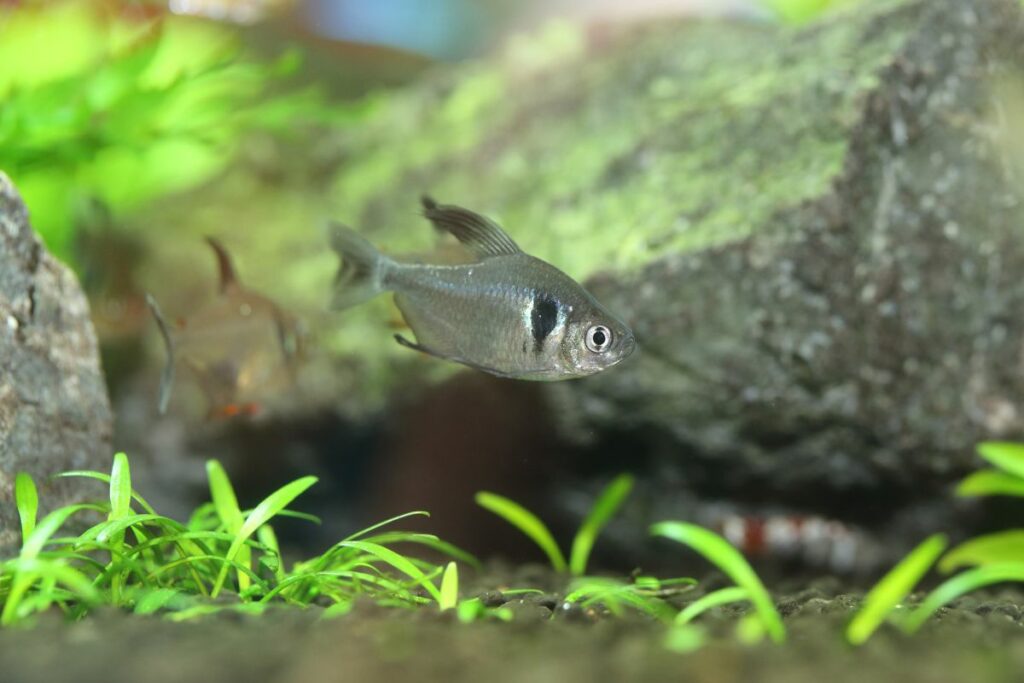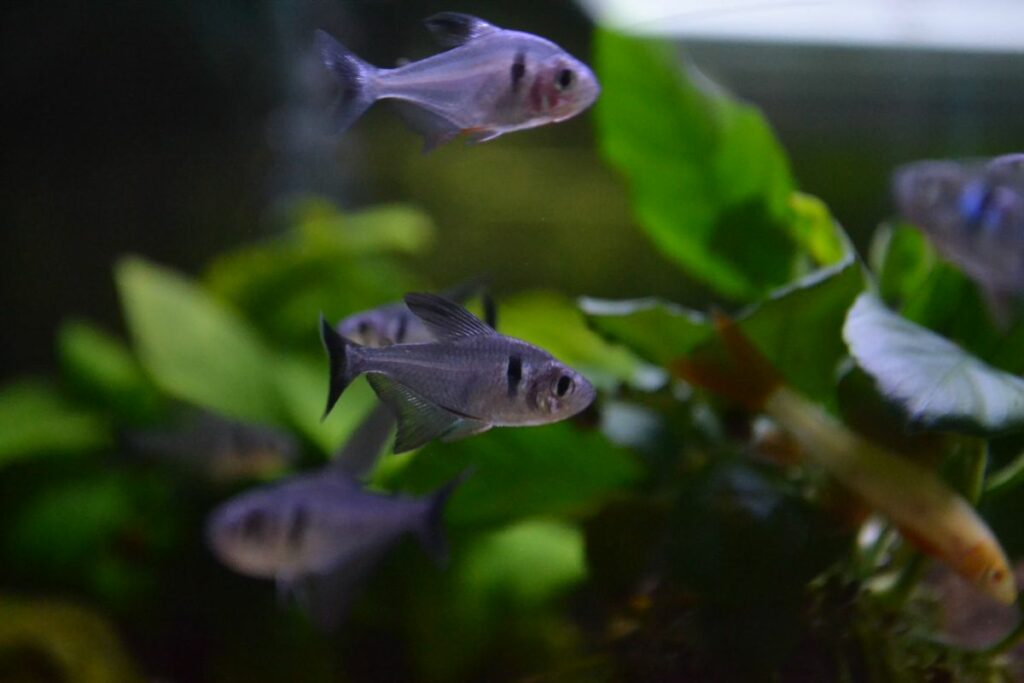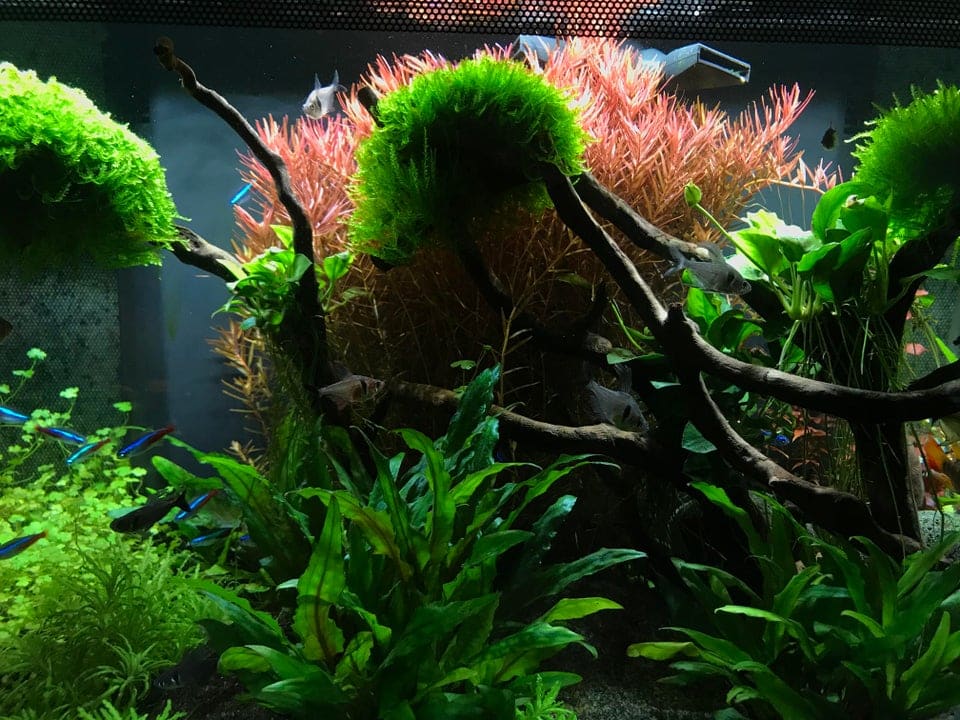The smokey gray and black tones of the black phantom tetra are a stunning change from the vibrant colors of other aquarium fish. Not to mention the elegant dorsal fin and schooling behavior.

Are these tetras as dark in temperament as their color? What is involved in caring for the black ghost tetra?
What is the Black Phantom Tetra?
Black phantom tetras are members of the family Characidae, which includes several popular aquarium tetras. They are close cousins of neon tetras and lemon tetras. Yet they have more subdued gray colors instead of shiny colors.
Dark phantom tetras have an eyespot behind their head and gills. It looks almost like a phantom is peering back at you, hence the name. These are theorized to be eyespots. Lots of animals have these. Eyespots confuse potential predators by mimicking the gaze of an even larger predator.
The spots may also help black phantom tetras blend together when schooling. They break up the outline of each individual fish. Swirling together to confuse predators enough that no individual fish gets picked off.
There is also a related species called the red phantom tetra (Hyphessobrycon sweglesi). They are even rarer in the aquarium hobby. Phantom red tetra fish are from the Orinoco river, on the opposite side of South America.
Red phantoms are similar in care needs but look more like serpae tetras. Besides the color difference, the males don’t have the tall dorsal fins of black phantoms.
- Common Name: Black Phantom Tetra, Black Ghost Tetra
- Scientific Name: Hyphessobrycon megalopterus
- Origin: Paraguay & Madeira River, Brazil & Bolivia
- Length: 1½ inches
- Aquarium Size: 20 gallons
- Temperament: Peaceful; Schooling
- Ease of Care: Easy
Black Phantom Tetra Care
Tetra fish are a little more challenging than livebearers or danios. But they are still hardy and long-lived so long as your water quality is excellent.
Black Phantom Tetra Size

Black phantom tetras are reasonable in size. Even adult females grow no larger than 1½ inches. If these were solitary fish a 10 gallon tank would be perfect. But like all tetras, black ghost tetras are schooling, social animals.
20 gallons is the minimum for a group of 6 fish. Which is the fewest black phantom tetras you should have. Any less and the tetras will stress and spend most of their time hiding.
If you have the space, buying more than 6 will help your black phantom tetras feel even more comfortable. 10 to 20 will form a gorgeous school, with males competing with each other for dominance. And females gliding around the tank, watching for potential suitors.
Plants and Substrate for Black Phantoms
Black phantom tetras are excellent aquarium fish for planted tanks. I’d go so far as to recommend keeping plants with tetra fish at all times. It’s hard to overstate how beneficial plants are for your aquarium.
Aquatic plants take in carbon dioxide and release oxygen into the water, like terrestrial plants and trees do. In doing so, they help aerate the aquarium.
Plants also use ammonia, nitrite, and nitrate as fertilizer. Black phantom tetras are hardy but also sensitive to these pollutants. Plants work alongside your beneficial bacteria to keep water conditions ideal for them.
Black phantom tetras also do best in moderate to low light conditions. Bright lights make them feel exposed. Their colors will wash out to a dull, unattractive gray to help them fade into the light.
Floating plants offer the most shade and benefits for the least amount of work. Duckweed, hornwort, red root floater, and water wisteria are a few floating plants carried by local pet stores.
Plants also provide a place for black phantom tetras to spawn. As egg scatterers, they use thickets of plants to hide and protect their young. Guppy grass and Java moss are two easy to grow plants that egg scattering fish prefer.
Your substrate should be the one that best supports plant growth. And matches your aesthetic needs. Black phantom tetras are midwater swimmers so they won’t spend much time around the bottom. Either gravel or sand will work for them.
Water Conditions for Black Phantom Fish
Black phantom tetras are easy fish to keep but they are still tetras. Tetra fish should never be the first fish you add to a new aquarium. They are sensitive to nitrogenous waste products like ammonia. Even low levels that would just stress a betta fish will kill black phantom tetras.
Once your tank is well cycled, your black phantom tetras will live for several years. Another way to ensure a long life is to match their water chemistry needs. These fish prefer neutral to acidic water conditions, with a pH of 5.5-7.0. Dissolved mineral content should be kept low as well.
They will tolerate some alkalinity but it will reduce their vitality, color, and resistance to disease. Tetra fish also won’t spawn in alkaline conditions (except for the Buenos Aires tetra).
Their preference for acidic conditions makes Indian almond leaves and driftwood good decorations for a tetra tank. Several kinds of driftwood have stores of tannic acids that will leach out into the water over time. Buffering your aquarium water towards acidity at all times.
Don’t forget to keep your water temperature high. Black phantom tetras are tropical fish and need a range of 73-83℉. Colder conditions will lower their appetite, growth rate, and desire to spawn.
Cold also increases their susceptibility to aquarium fish ich and other diseases. Once tetras get ich they are hard to cure as they are sensitive to aquarium salt and other medications.
What Do Black Phantom Tetras Eat?
Black phantoms are carnivorous fish. They feed on small invertebrates they find in the wild: aquatic worms, insect larvae, small crustaceans, and other creatures.
They adapt well to flakes and micro pellets in captivity. But you should still offer them regular treats of live and frozen fish food.
Brine shrimp, black worms, tubifex worms, daphnia, blood worms…Black phantom tetras need these for dietary diversity in the form of extra fat and protein. Extra fat, in particular, helps them create eggs and sperm for breeding.
As small, active fish, feed black phantom tetras two or three times per day. Feed as much as they will eat in 3 to 5 minutes. With no leftover food that will pollute water quality.
Black Phantom Tetra Tank Mates

Dark phantom fish are easy to keep with other community aquarium fish. They are peaceful and sociable, keeping to themselves. They aren’t fin nippers, unlike several larger tetra fish. So they are safe as tank mates for bettas, fancy guppies, swordtails, and other long-finned fish.
Choose aquarium fish that are peaceful, not much larger, and enjoy acidic to neutral water conditions. Some good choices include:
Breeding the Black Ghost Tetra
Black phantom tetras are not easy to breed fish. But it is possible. If you have a planted aquarium with acidic water and no trace of nitrogenous waste, you have a good chance of doing so.
Black Phantom Tetra Male vs Female
Sexing the black phantom tetra is a lot easier than it is with other tetra fish. They are sexually dimorphic. Meaning you are able to tell males from females by looking at them.
Male black phantom tetras have the tall, curving dorsal fin. Even when young, the male tetra’s dorsal fin will be rounder and taller.
The anal fin is also longer, with a distinct point when relaxed. The anal fin’s point unfurls into a rounded edge when held erect. Dominant males or males in spawning condition will turn jet black instead of dark gray.
Female black phantom tetras are much rounder and thicker thanks to their egg-producing ovaries. They also have a pair of red pelvic fins. The red color may also extend to the anal and adipose fin but not always.
Spawning the Black Phantom Tetra
As spawning time grows near, the males increase their sparring activity. They may even start nipping each other’s fins. Torn fins will heal over time so no need to discourage them. The females will also swell up as they produce eggs.
Pairs of fish spawn during the dawn or dusk periods of the day, when light levels are low. Setting your aquarium lights on a timer will help replicate a natural cycle of daylight.
Being egg scatterers, black phantom tetras don’t provide parental care for their young. Once the eggs are laid, the parents forget about them. So you need to be proactive in removing any plant material with eggs attached. Otherwise, they will find and eat their eggs or fry.
Black panthom tetra fry are tiny after hatching. So small that they can’t eat baby brine shrimp. They need to eat cultured infusoria their first week. After 7 days, they will be large enough to eat brine shrimp nauplii. Which should be alive since tetra fry are sensitive to motion.
Conclusion
Black phantom tetra fish are interesting departures from the usual blue, red, and golds of aquarium fish. Their flowing fins add to their ghost-like appearance. And they offer enough of a challenge to make spawning them feel like a true accomplishment.
FAQs
Black phantom tetras are hardy tetras. But all tetra fish are more sensitive to nitrogenous waste than other aquarium fish. As long as your tank is cycled and healthy, black phantom tetras will thrive there. But if ammonia levels rise, they will be the first to show stress.
Black phantom tetras are good betta fish tank mates. They don’t nip fins and are peaceful. You do need a larger aquarium than a 5 gallon betta fish tank. Black phantom tetras are active, schooling fish that need a minimum of 20 gallons of space.

